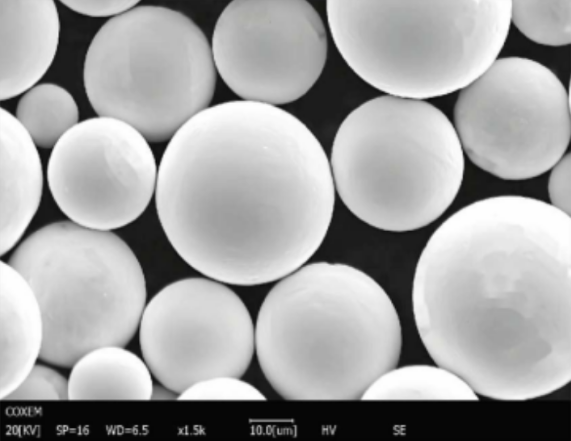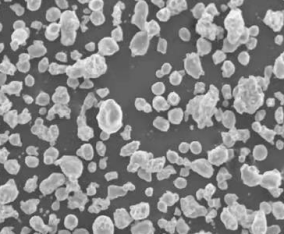Imagine a world where parts are not just built, but meticulously crafted on a layer-by-layer basis, with properties exceeding those of traditional manufacturing methods. This is the realm of additive manufacturing, also known as 3D printing, and a key player in this revolution is the unsung hero – cobalt-based alloy powders.
What is Cobalt-Based Alloy Powders?
Cobalt-based alloy powder is a finely-ground metal mixture where cobalt takes center stage. Just like a superhero team, cobalt combines its strengths with other elements like chromium, molybdenum, tungsten, and nickel to create a unique set of properties. These specially formulated powders are the building blocks for creating high-performance parts through techniques like laser melting and electron beam melting.
Preparation Methods of Cobalt-Based Alloy Powder
There are two main methods for conjuring these metallic marvels:
- Gas Atomization: Imagine molten metal being poured through a sieve under a high-pressure gas stream. The rapidly cooling droplets solidify into tiny, near-perfect spheres – the ideal shape for 3D printing.
- Water Atomization: Similar to gas atomization, but instead of a gas stream, a water jet breaks down the molten metal, resulting in a more irregular powder morphology.

The Properties of Cobalt-Based Alloy Powders
These mighty metal marvels possess a combination of traits that make them irreplaceable in various applications:
- High-Temperature Strength: Think of a jet engine roaring at scorching temperatures. Cobalt-based alloy powders can withstand such extreme conditions without warping or losing their integrity.
- Corrosion Resistance: Saltwater, harsh chemicals – these elements pose no threat to cobalt-based alloy parts. They stand strong against environmental attacks, making them ideal for marine and chemical processing applications.
- Wear Resistance: Friction is the enemy of many components. But cobalt-based alloy powders scoff at wear and tear, ensuring parts maintain their functionality for extended periods.
- Biocompatibility: For those seeking life-changing implants, cobalt-based alloys, specifically formulated for biocompatibility, are a boon. These alloys are gentle on the human body, making them perfect for dental implants and prosthetic joints.
Applications Fields of Cobalt-Based Alloy Powders
The versatility of cobalt-based alloy powders extends to a wide range of industries:
| Industry | Applications |
|---|---|
| Aerospace | Turbine blades, combustor liners, landing gear components |
| Automotive | High-performance engine parts, lightweight components |
| Medical | Dental implants, joint replacements, surgical instruments |
| Chemical Processing | Pumps, valves, heat exchangers |
| Oil & Gas | Drilling tools, downhole components |
| Consumer Goods | Cutting tools, wear-resistant components |

Common Cobalt-Based Alloy Powder Models and Their Applications
Here’s a deeper dive into some specific cobalt-based alloy powder models and their strengths:
- CoCrMo (Cobalt-Chromium-Molybdenum): A workhorse material, offering excellent high-temperature strength, corrosion resistance, and biocompatibility. It’s widely used in aerospace, medical, and chemical processing applications.
- CoCrW (Cobalt-Chromium-Tungsten): Compared to CoCrMo, this model boasts even better wear resistance, making it ideal for applications like bearings and cutting tools.
- Inconel (Nickel-Chromium-Cobalt): A family of cobalt-based alloy powders known for their exceptional resistance to harsh environments and high temperatures. They find use in jet engines, heat exchangers, and chemical processing equipment.
- MP1 (Cobalt-Nickel-Chromium-Molybdenum): This biocompatible alloy is a popular choice for medical implants due to its excellent corrosion resistance and ability to osseointegrate (bond with bone).
- Maraging Steel (Cobalt-Iron-Molybdenum): Known for their high strength-to-weight ratio, maraging steels are used in aerospace applications where weight reduction is critical.
- Tribaloy (Cobalt-Chromium-Molybdenum-Tungsten-Carbon): This champion of wear resistance finds use in applications like gears, bearings, and pump components.
- Stellites (Cobalt-Chromium-Tungsten-Carbon): Another wear-resistant champion, particularly well-suited for high-temperature environments like valves and cutting tools.
- HA (Hydroxyapatite): This unique model blends cobalt-chromium with a calcium phosphate ceramic, mimicking the composition of natural bone. This makes it ideal for advanced orthopedic implants that promote bone growth.
Advantages and Limitations of Cobalt-Based Alloy Powders
Advantages:
- Exceptional mechanical properties: From high-temperature strength to wear resistance, these powders deliver unparalleled performance in demanding applications.
- Design freedom: Unlike traditional manufacturing methods, 3D printing with cobalt-based alloy powders allows for complex geometries and lightweight designs.
- Reduced waste: The targeted, layer-by-layer approach of 3D printing minimizes material waste compared to subtractive manufacturing techniques.
- Customization: The ability to fine-tune the composition of the powder allows for tailored properties for specific applications.
Limitations:
- Cost: Cobalt-based alloy powders can be expensive compared to some conventional materials.
- Surface finish: 3D printed parts may require post-processing for a smoother surface finish.
- Limited build size: Current 3D printing technology has limitations on the size of parts that can be produced with cobalt-based alloy powders.
- Health concerns: Cobalt dust inhalation can pose health risks, requiring proper handling procedures during the printing process.
Choosing the Right Cobalt-Based Alloy Powder
With such a diverse range of options, selecting the right cobalt-based alloy powder hinges on understanding your specific needs. Here are some key factors to consider:
- Application: The demands of your project will dictate the most crucial properties. For high-temperature applications, focus on alloys like Inconel. For wear resistance, CoCrW or Tribaloy might be better choices.
- Biocompatibility: If the part will interact with the human body, biocompatible alloys like MP1 or HA are essential.
- Printability: Different powders have varying flow characteristics that impact printability. Consult with your 3D printing service provider to ensure compatibility with their machines.
- Cost: Cobalt-based alloy powders can be a significant investment. Weigh the cost against the performance benefits it offers for your application.
Specifications, Sizes, Grades, and Standards
Several factors define the specific characteristics of cobalt-based alloy powders:
- Chemical Composition: The precise mix of elements like cobalt, chromium, molybdenum, etc., determines the powder’s properties.
- Particle Size Distribution: The size and distribution of the powder particles significantly impact flowability, printability, and the final part’s surface finish. Common size ranges include 15-45 microns and 45-100 microns.
- Powder Flow: The powder’s ability to flow freely is crucial for even deposition during the 3D printing process.
- Density: The density of the powder translates to the density of the final printed part.
- Standards: Depending on the application, the powder may need to adhere to specific industry standards like ASTM F2904 for medical implants or AMS 5664 for aerospace components.
Suppliers and Pricing
Several reputable suppliers offer cobalt-based alloy powders, with pricing varying depending on the specific model, quantity, and particle size. Here’s a glimpse into the range (expect fluctuations based on market conditions):
- CoCrMo: $50 – $100 per kilogram
- CoCrW: $75 – $120 per kilogram
- Inconel: $100 – $150 per kilogram
- Biocompatible Alloys (MP1, HA): $150 – $200 per kilogram
FAQ
Q: Are cobalt-based alloy powders safe?
A: Generally, cobalt-based alloy parts are safe once printed. However, cobalt dust inhalation during the printing process can pose health risks. Proper ventilation and safety protocols are essential when handling these powders.
Q: What are the alternatives to cobalt-based alloy powders?
A: Depending on the application, alternative materials like stainless steel, titanium alloys, or even polymer-based powders might be suitable. However, these options may not offer the same level of performance as cobalt-based alloys in terms of high-temperature strength, wear resistance, or biocompatibility.
Q: Can I use cobalt-based alloy powders with my home 3D printer?
A: While some hobbyist-grade 3D printers can handle metal powders, cobalt-based alloys generally require specialized industrial machines with advanced safety features. The high cost of the powder and the complexity of handling it make it less suitable for home use.

